Related Topics
- [Windows 11/10] Troubleshooting - Resolving System Error Messages or Unresponsiveness (Freeze/Black Screen/White Screen during usage)
- Laptop Frequently Asked Question (FAQ)
- [Windows 11/10] Troubleshooting - Unable to Shut Down
- [Windows 11/10] Troubleshooting - System is running slowly
- [Windows 11/10] Troubleshooting - Blue Screen Errors in Windows (BSOD)
[Windows 11/10] Troubleshooting - Automatic Shutdown/Restart Issues
Applicable Products: Notebook, Desktop, All-in-One PC, Gaming Handheld, Motherboard, Graphics card
The causes of automatic shutdowns/restarts in devices can vary, ranging from hardware issues such as the motherboard, hard drive, and memory, to software-related factors like applications, drivers, and the Windows operating system. Another significant factor could be problems with the internal cooling system of the device, leading to elevated CPU temperatures triggering protective shutdown mechanisms. For more information on addressing cooling issues, please refer to Troubleshooting - Overheating and Fan issues. For troubleshooting unexpected automatic shutdowns/restarts on other devices, please consult the steps outlined in this article.
Please go to the corresponding instruction based on the current Windows operating system on your device:
Update BIOS, Windows packages, and drivers
Regularly updating BIOS, Windows, and drivers can enhance system stability and performance. Ensure that your device is using the latest versions. Learn more about updating BIOS:
How to use update the BIOS version in Windows system
How to use EZ Flash to update the BIOS version
(For desktop products, please refer to ASUS Motherboard EZ Flash 3 Introduction.)
For executing Windows update and drivers update, here you can learn more about:
How to update drivers via System Update in MyASUS
If you have updated the BIOS, Windows packages, and drivers to the latest version, but the issue persists, please proceed to the next troubleshooting step.
Run Hardware diagnostic via MyASUS
You can inspect whether the hardware device is good by the Hardware Diagnostic via MyASUS. If any error occurs after diagnosing, we recommend that you visit ASUS repair center to replace the hardware device.
- Type and search [MyASUS] in the Windows search bar①, then click [Open]②.
Note: If you cannot find MyASUS, it may not be installed on your device. Refer to How to install MyASUS.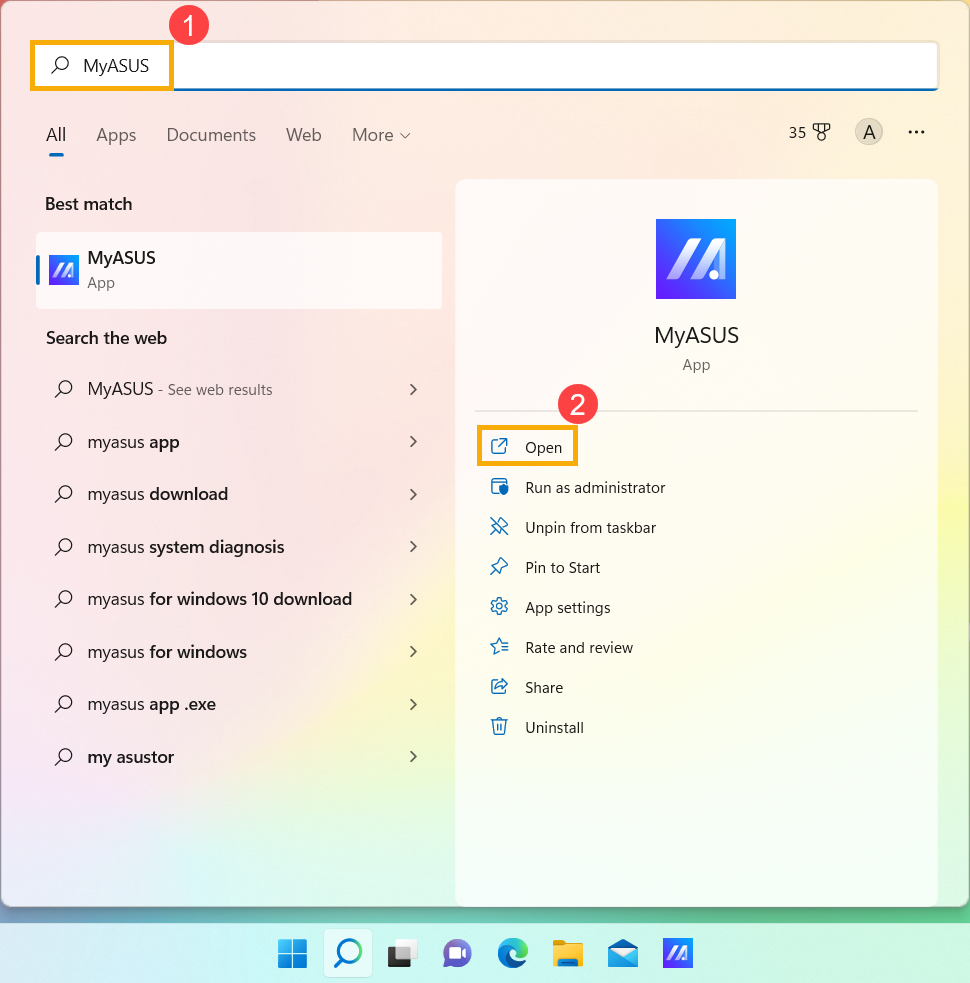
- In the MyASUS app, click [System Diagnosis]③.
Note: If your device does not display the system diagnosis page in MyASUS software, it means your device does not support this feature. Continue to the next section for further troubleshooting. Here you can learn more about Why can I only see the partial features in the MyASUS app.
- In [Diagnostic Tool]④, select [All] check items of Customized diagnosis⑤, and then click [Checkup]⑥. Here you can learn more about MyASUS System Diagnosis - Introduction.
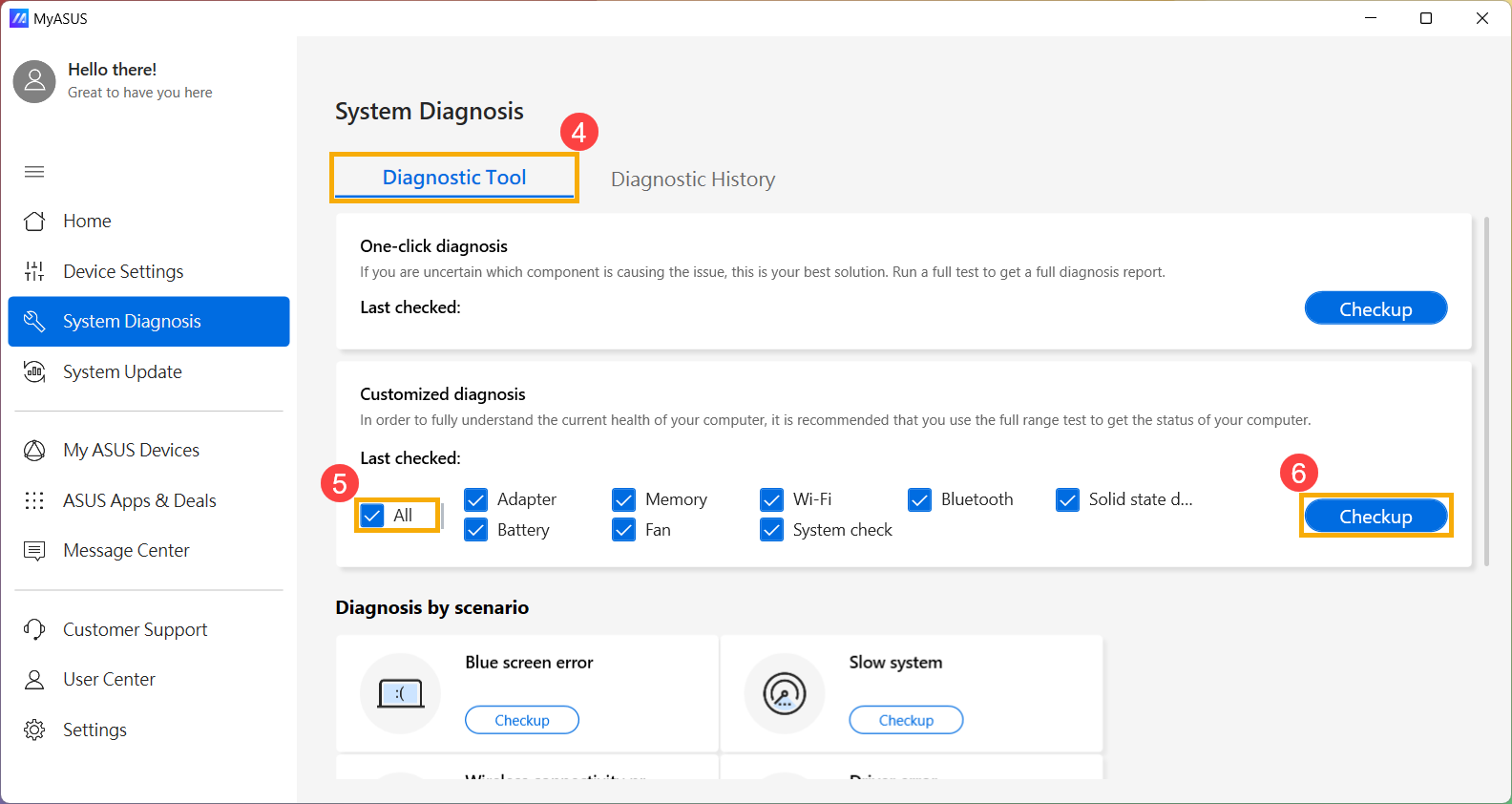
- If any error occurs, please visit ASUS repair center to replace the hardware device. Here you can learn more about How to use Customer Support to contact ASUS for the further repair request.
If no issue is found after the ‘System Diagnosis check’, it means your hardware devices are good. Please continue to the next troubleshooting step.
Check external peripherals or any hardware devices installed / changed
Sometimes, the external devices connected to your device can be the cause of Blue Screen Errors, so please try to remove them, such as external hard drives, printers, memory cards, external ODD (if your device is with internal ODD, please remove CD/DVDs), dongles, etc. After that, restart your device. If you don’t experience the issue after restarting your device, the external device may be the cause of the problem. We recommend that you do not use this device and contact your device manufacturer for support.
If you do not use any external devices or the problem still persists after removing them, please confirm whether you had ever installed / replaced any hardware devices, such as disk drives (HDD or SSD) or Memory modules. The compatibility problem could be the cause and exist between new hardware devices and ASUS products / system, so please try to remove the hardware device. If you don’t experience the issue after removing the hardware device, we recommend that you do not use this device and contact your device manufacturer for support.
If the problem persists after above steps, please continue the next troubleshooting step.
Check recently installed / updated software or applications
Some problems may occur after Windows Update or a specific application installed in your device, including the compatibility issue between applications and system, or Windows core programs may be crashed.
You can view update history to check recently installed updated items.
- Type and search [Windows Update settings] in the Windows search bar①, then click [Open]②.
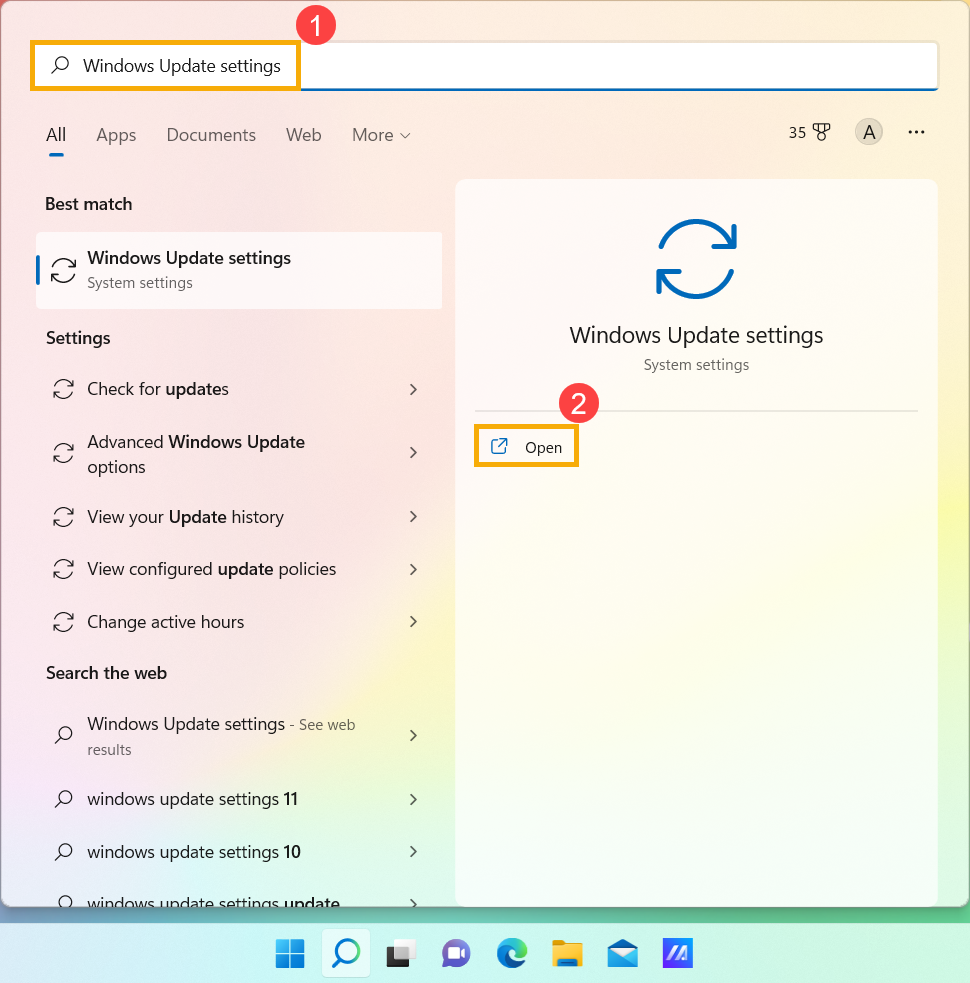
- Select [Update history]③.
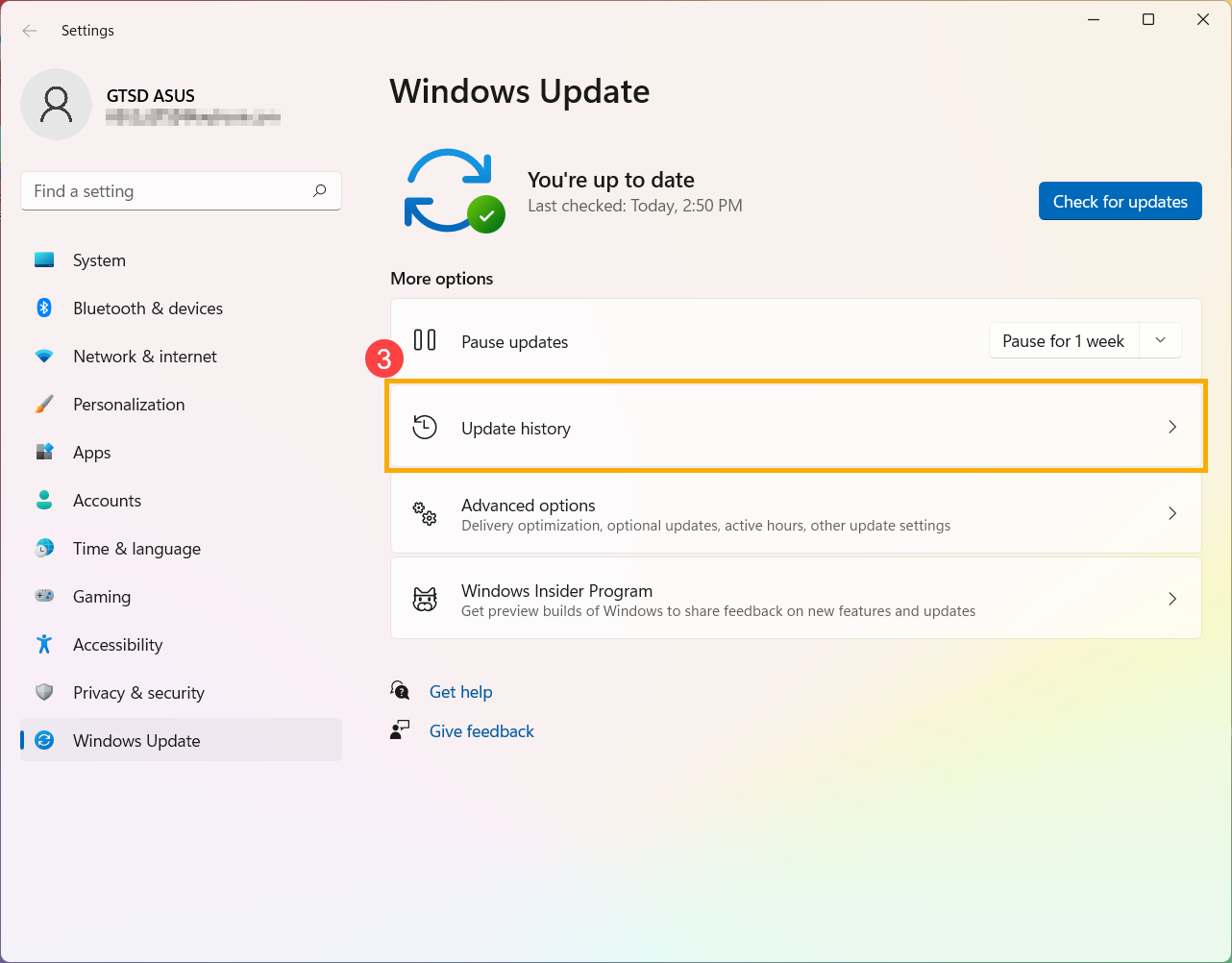
- In Update history, it will list Feature Updates, Quality Updates and Driver Updates, etc. that had been installed on your device.
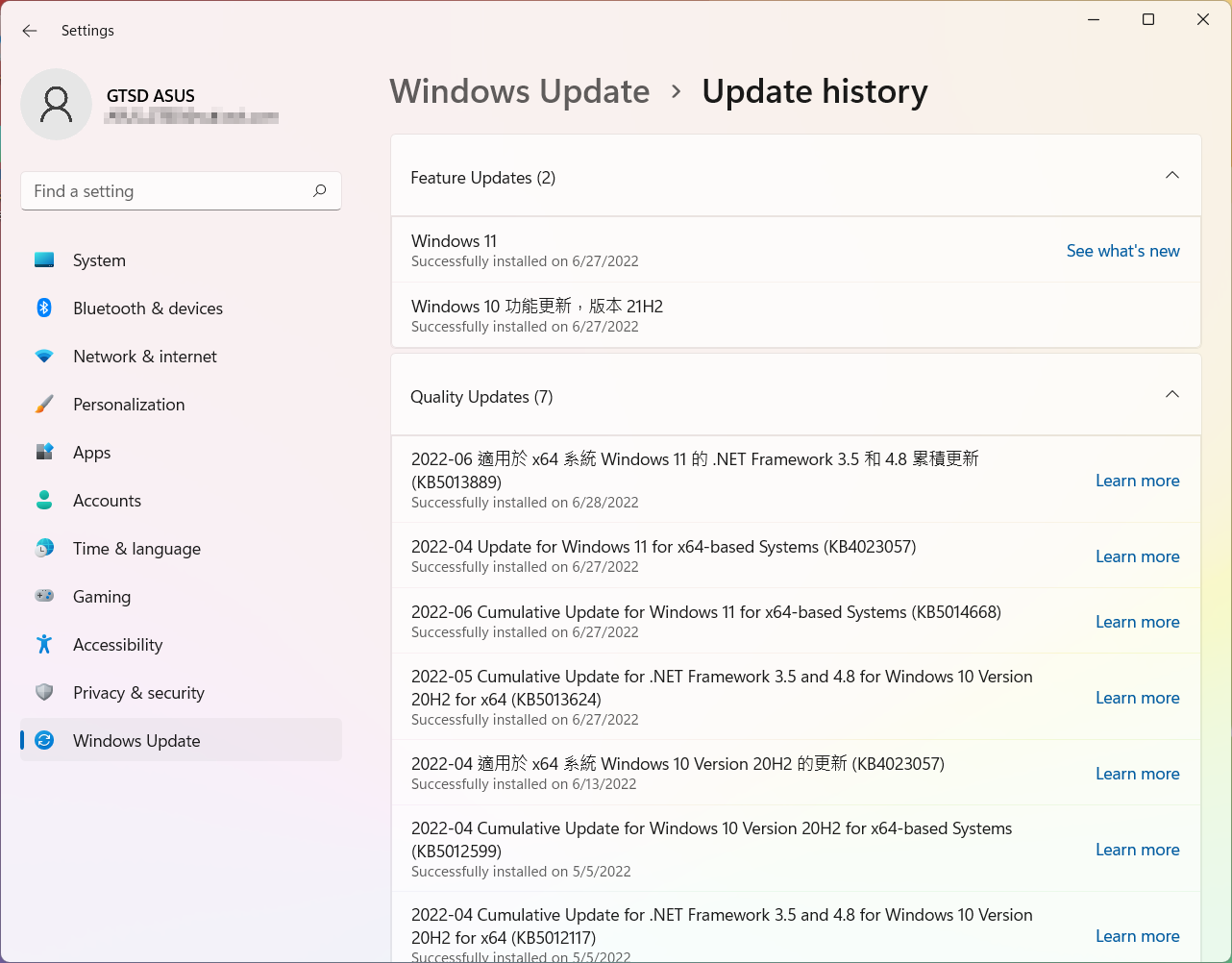
- You can confirm the installed date and whether you experience auto shutdown/restart problem after that, and then refer to the following steps to know how to uninstall or go back to the previous version.
Go back to the previous version of Feature Updates
If you experience auto shutdown/restart problem after installing feature updates in Windows, we recommend that you go back to the previous version and wait for the modification from Microsoft in order to prevent any initial unstable problem. Here you can learn more about How to go back to the previous version of Windows.
If you cannot go back to the previous version of Windows, we recommend that you restore the system from restore point, here you can learn more about How to use restore point to restore the system.
Uninstall Quality Windows Updates
If you experience auto shutdown/restart problem after installing quality updates in Windows, we recommend that you uninstall the update and wait for the modification from Microsoft, please refer to the following steps to know how to uninstall it.
- In Update history, click [Uninstall updates]①.
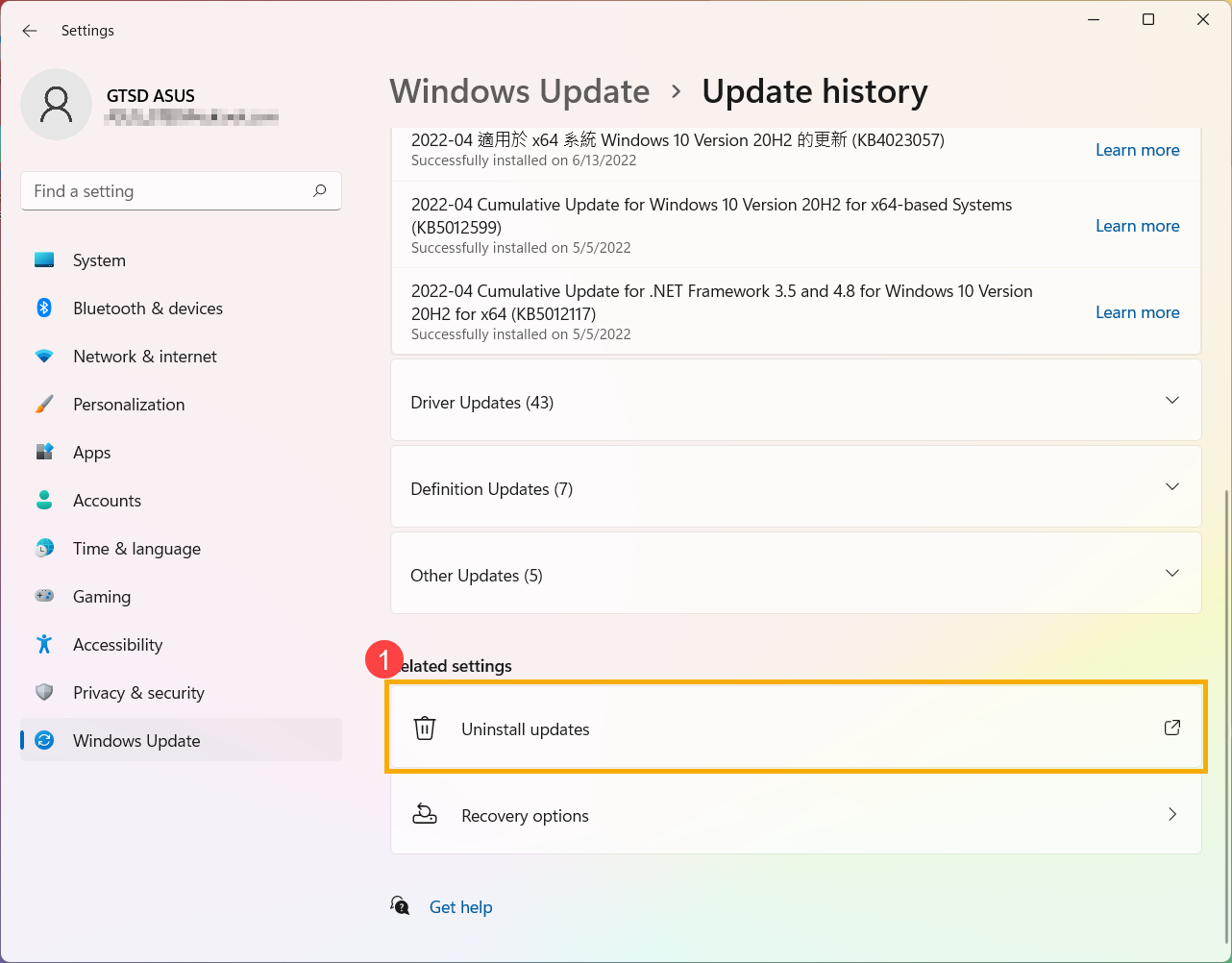
- Select the item which you want to remove②, then click [Uninstall]③.
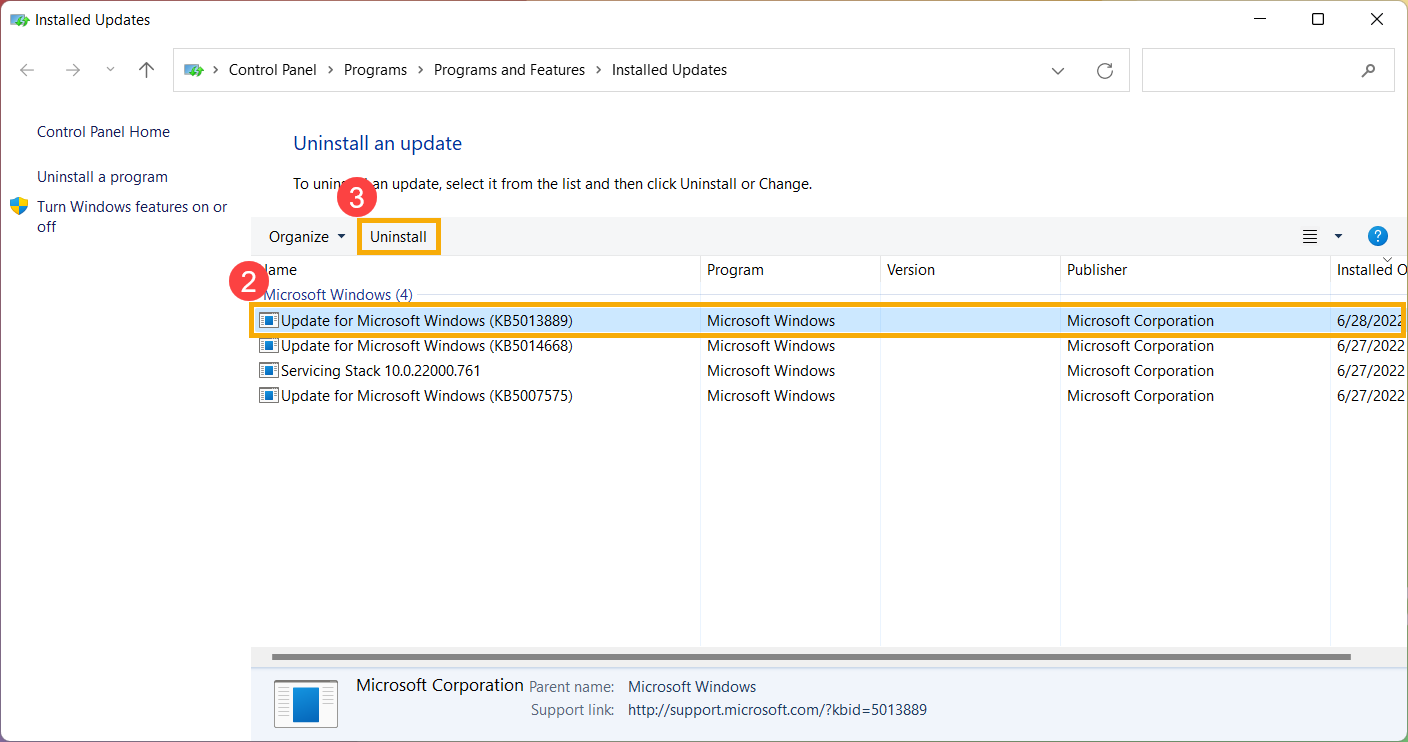
Go back to the previous drivers version
If you experience auto shutdown/restart problem after updating drivers in Windows, we recommend that you go back to the previous version and wait for the fixed one. Please refer to the following steps to know how to go back to the previous driver version.
- Type and search [Device Manager] in the Windows search bar①, then click [Open]②.
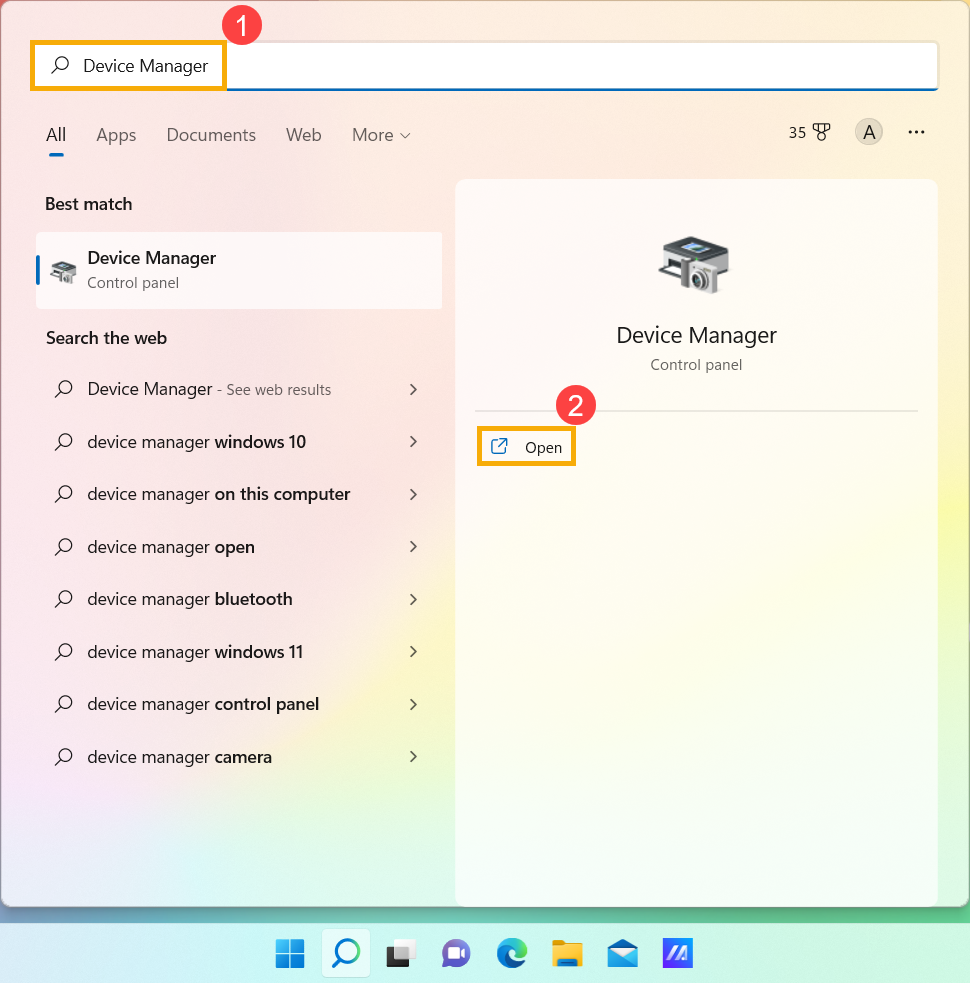
- Check the arrow next to [Display adapters]③, then right-click the [Intel(R) UHD Graphics 620]④ and select [Properties]⑤.
The following steps are used Intel graphics as an example, please select the defective driver which you would like to roll back to the previous version.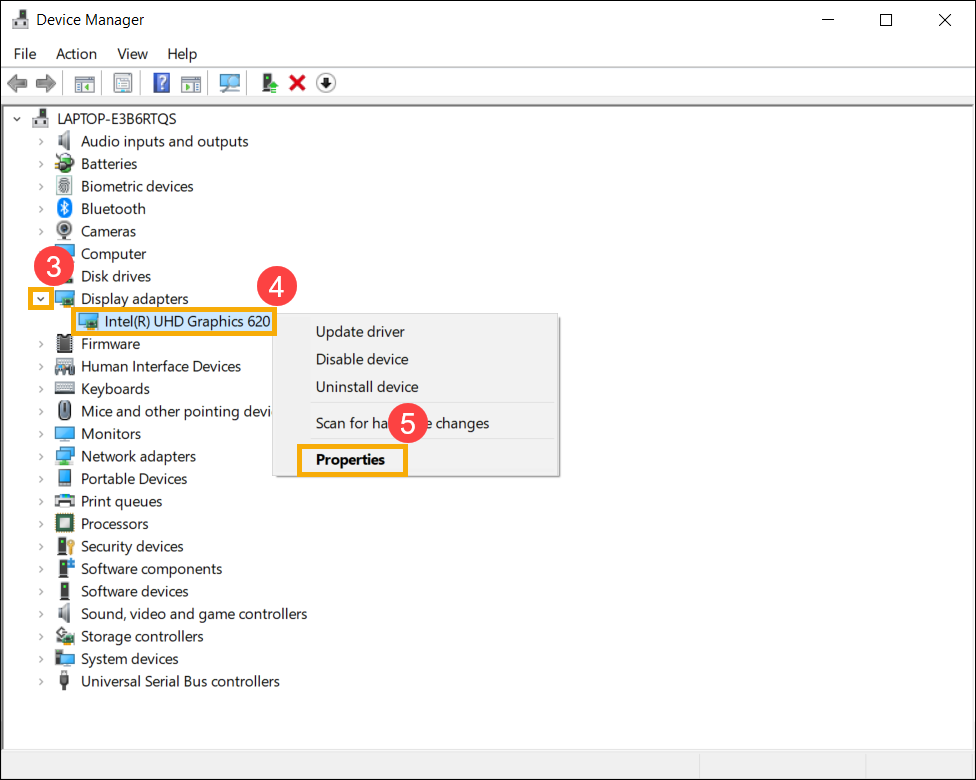
- Select [Driver]⑥, then select [Roll Back Driver]⑦.
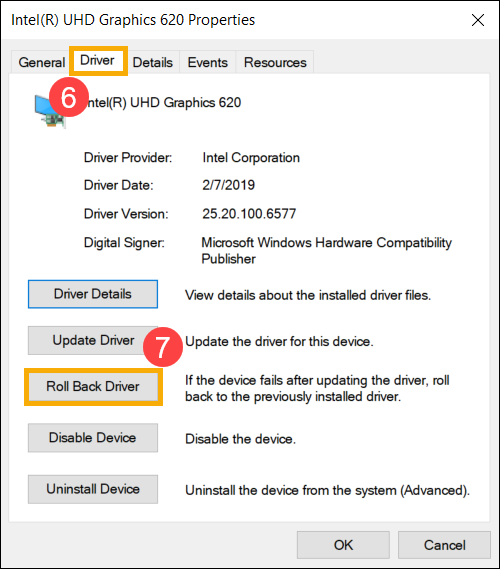
- Select the reason of [Why are you rolling back?]⑧, then click [Yes]⑨. The system will start rolling back to the previously installed driver.
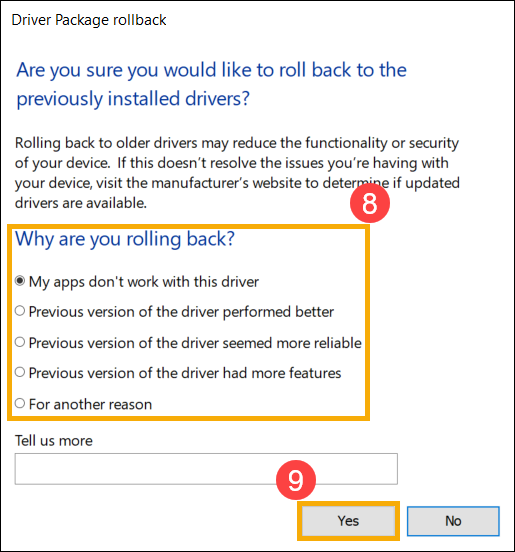
Uninstall a specific application
Auto shutdown/restart problem may occur if there is a compatibility issue between an initial installed application and Windows system, so we recommend that you uninstall this application first. Here you can learn more about How to search or uninstall recently installed applications.
If the problem is gone after uninstalling this application, we recommend that you check the supported Operating System or specification in this application’s official website, or contact the application manufacturer for support.
If the problem persists after above steps, please continue to the next troubleshooting step.
Restore the system from restore point
If the problem happens recently, and if you have ever created a restore point or there is an automatic system restore existed, try to restore the device to a point before the problem began to resolve the problem. Here you can learn more about How to use restore point to restore the system.
If the problem persists, please continue to the next chapter for troubleshooting.
Reset your PC
If the problem persists after all troubleshooting steps are completed. Please backup your personal files, then reset the device to back to its original configuration. Here you can learn more about How to reset the system.
Update BIOS, Windows packages, and drivers
Regularly updating BIOS, Windows, and drivers can enhance system stability and performance. Ensure that your device is using the latest versions. Learn more about updating BIOS:
How to use update the BIOS version in Windows system
How to use EZ Flash to update the BIOS version
(For desktop products, please refer to ASUS Motherboard EZ Flash 3 Introduction.)
For executing Windows update and drivers update, here you can learn more about:
How to update drivers via System Update in MyASUS
If you have updated the BIOS, Windows packages, and drivers to the latest version, but the issue persists, please proceed to the next troubleshooting step.
Run Hardware diagnostic via MyASUS
You can inspect whether the hardware device is good by the Hardware Diagnostic via MyASUS. If any error occurs after diagnosing, we recommend that you visit ASUS repair center to replace the hardware device.
- Type and search [MyASUS] in the Windows search bar①, then click [Open]②.
Note: If you cannot find MyASUS, it may not be installed on your device. Refer to How to install MyASUS.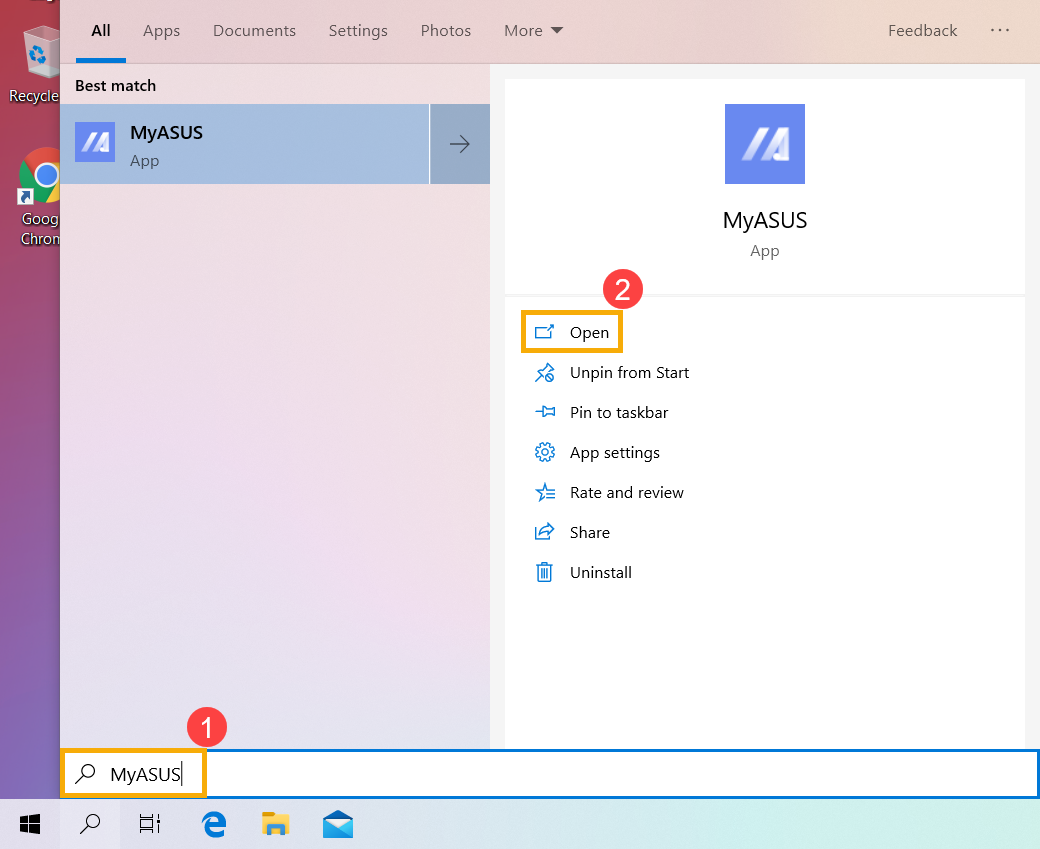
- In the MyASUS app, click [System Diagnosis]③.
Note: If your device does not display the system diagnosis page in MyASUS software, it means your device does not support this feature. Continue to the next section for further troubleshooting. Here you can learn more about Why can I only see the partial features in the MyASUS app.
- In [Diagnostic Tool]④, select [All] check items of Customized diagnosis⑤, and then click [Checkup]⑥. Here you can learn more about MyASUS System Diagnosis - Introduction.

- If any error occurs, please visit ASUS repair center to replace the hardware device. Here you can learn more about How to use Customer Support to contact ASUS for the further repair request.
If no issue is found after the ‘System Diagnosis check’, it means your hardware devices are good. Please continue to the next troubleshooting step.
Check external peripherals or any hardware devices installed / changed
Sometimes, the external devices connected to your device can be the cause of Blue Screen Errors, so please try to remove them, such as external hard drives, printers, memory cards, external ODD (if your device is with internal ODD, please remove CD/DVDs), dongles, etc. After that, restart your device. If you don’t experience the issue after restarting your device, the external device may be the cause of the problem. We recommend that you do not use this device and contact your device manufacturer for support.
If you do not use any external devices or the problem still persists after removing them, please confirm whether you had ever installed / replaced any hardware devices, such as disk drives (HDD or SSD) or Memory modules. The compatibility problem could be the cause and exist between new hardware devices and ASUS products / system, so please try to remove the hardware device. If you don’t experience the issue after removing the hardware device, we recommend that you do not use this device and contact your device manufacturer for support.
If the problem persists after above steps, please continue the next troubleshooting step.
Check recently installed / updated software or applications
Some problems may occur after Windows Update or a specific application installed on your device, including the compatibility issue between applications and system, or Windows core programs may be crashed.
You can view update history to check recently installed updated items.
- Type and search [Windows Update settings] in the Windows search bar①, then click [Open]②.
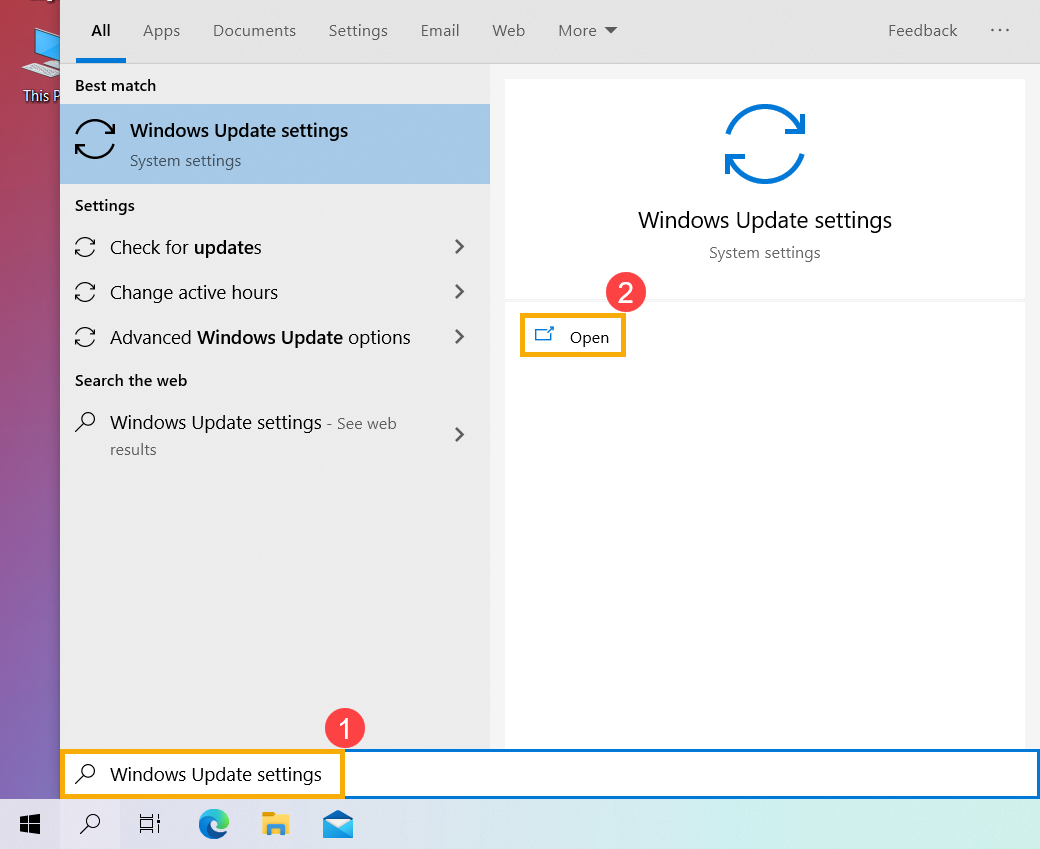
- Select [View update history]③.
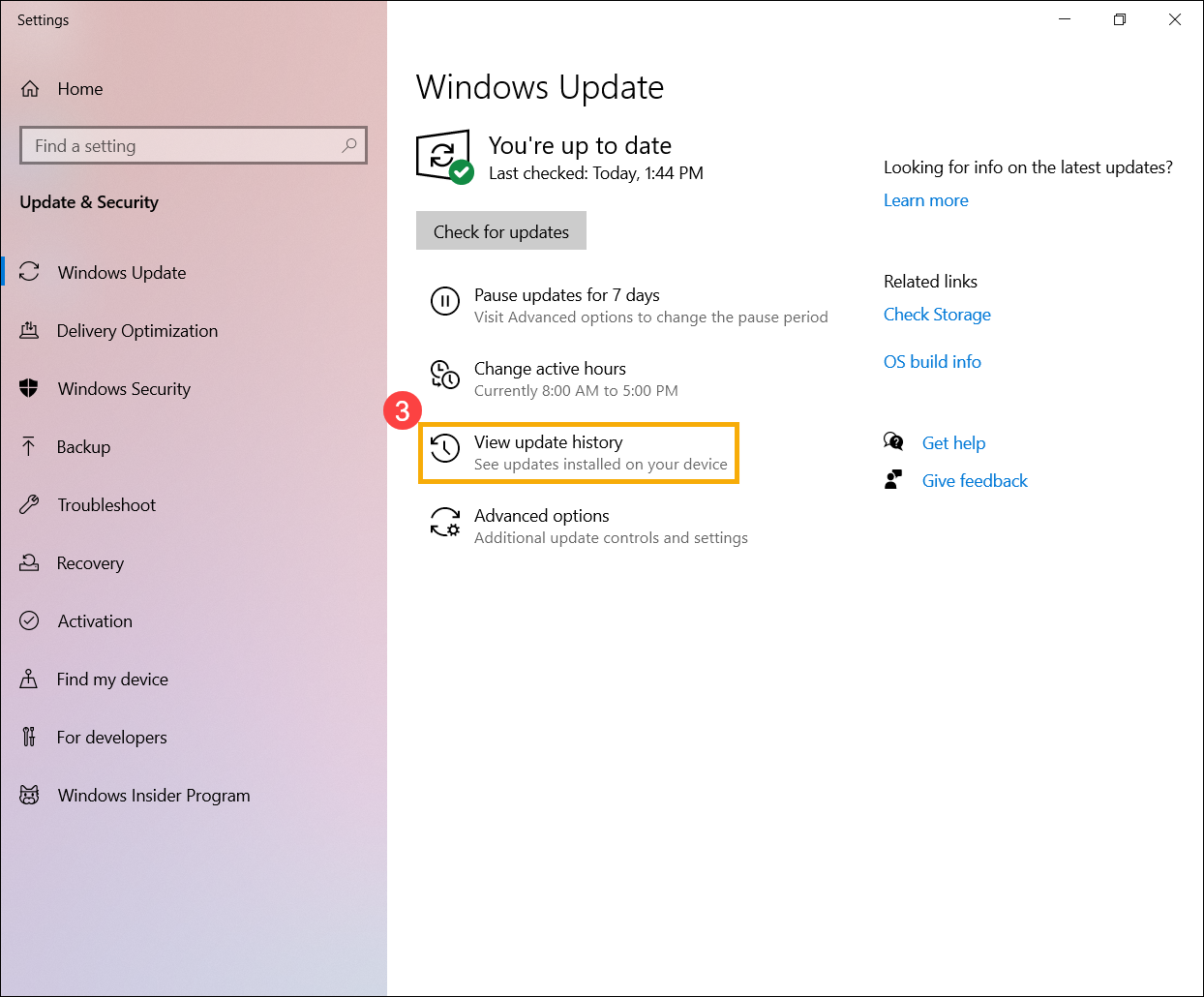
- In View update history, it will list Feature Updates, Quality Updates and Driver Updates, etc. that had been installed on your device.
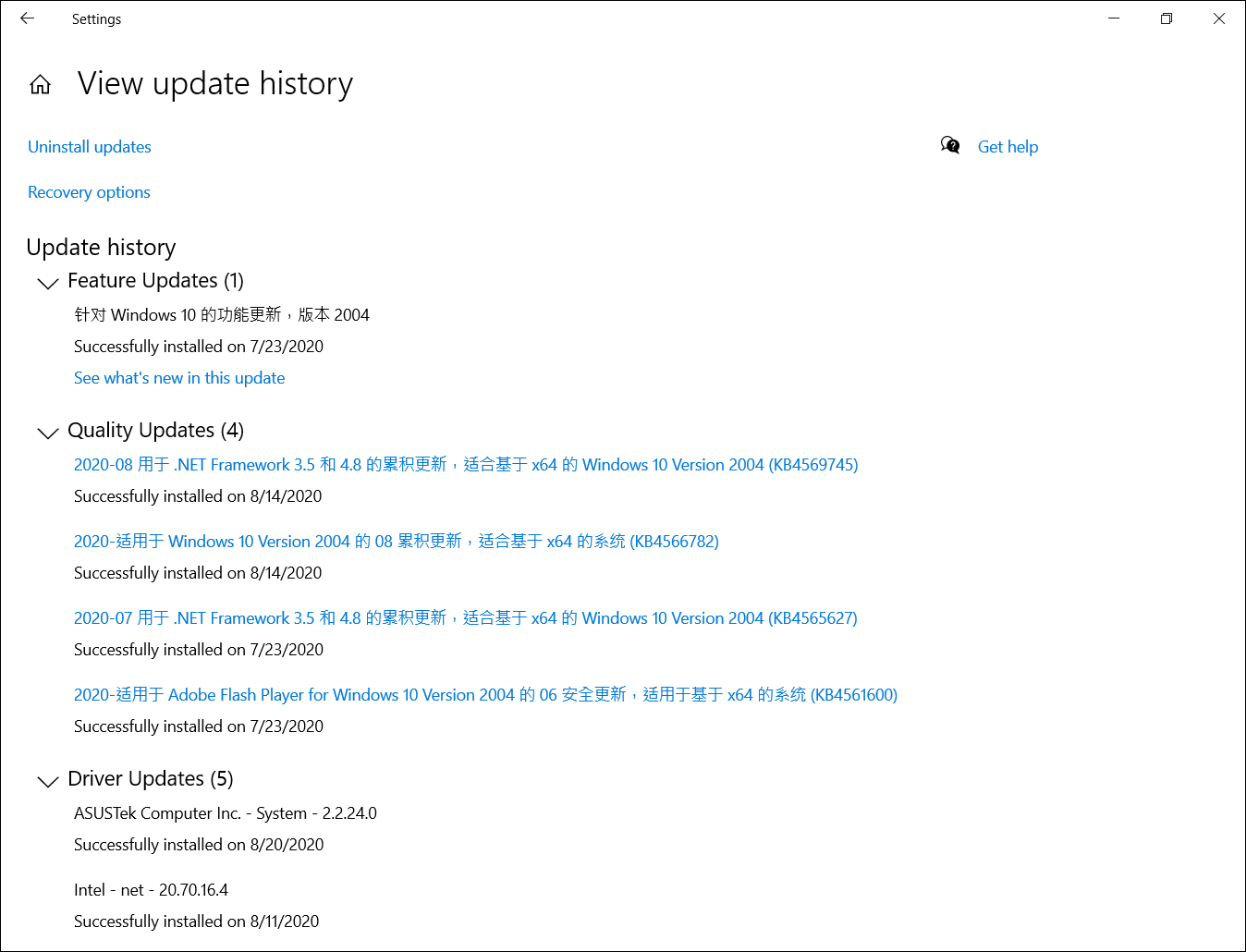
- You can confirm the installed date and whether you experience auto shutdown/restart problem after that, and then refer to the following steps to know how to uninstall or go back to the previous version.
Go back to the previous version of Feature Updates
If you experience auto shutdown/restart problem after installing feature updates in Windows, we recommend that you go back to the previous version and wait for the modification from Microsoft in order to prevent any initial unstable problem. Here you can learn more about How to go back to the previous version of Windows.
If you cannot go back to the previous version of Windows, we recommend that you restore the system from restore point, here you can learn more about How to use restore point to restore the system.
Uninstall Quality Windows Updates
If you experience auto shutdown/restart problem after installing quality updates in Windows, we recommend that you uninstall the update and wait for the modification from Microsoft, please refer to the following steps to know how to uninstall it.
- In View update history, click [Uninstall updates]①.
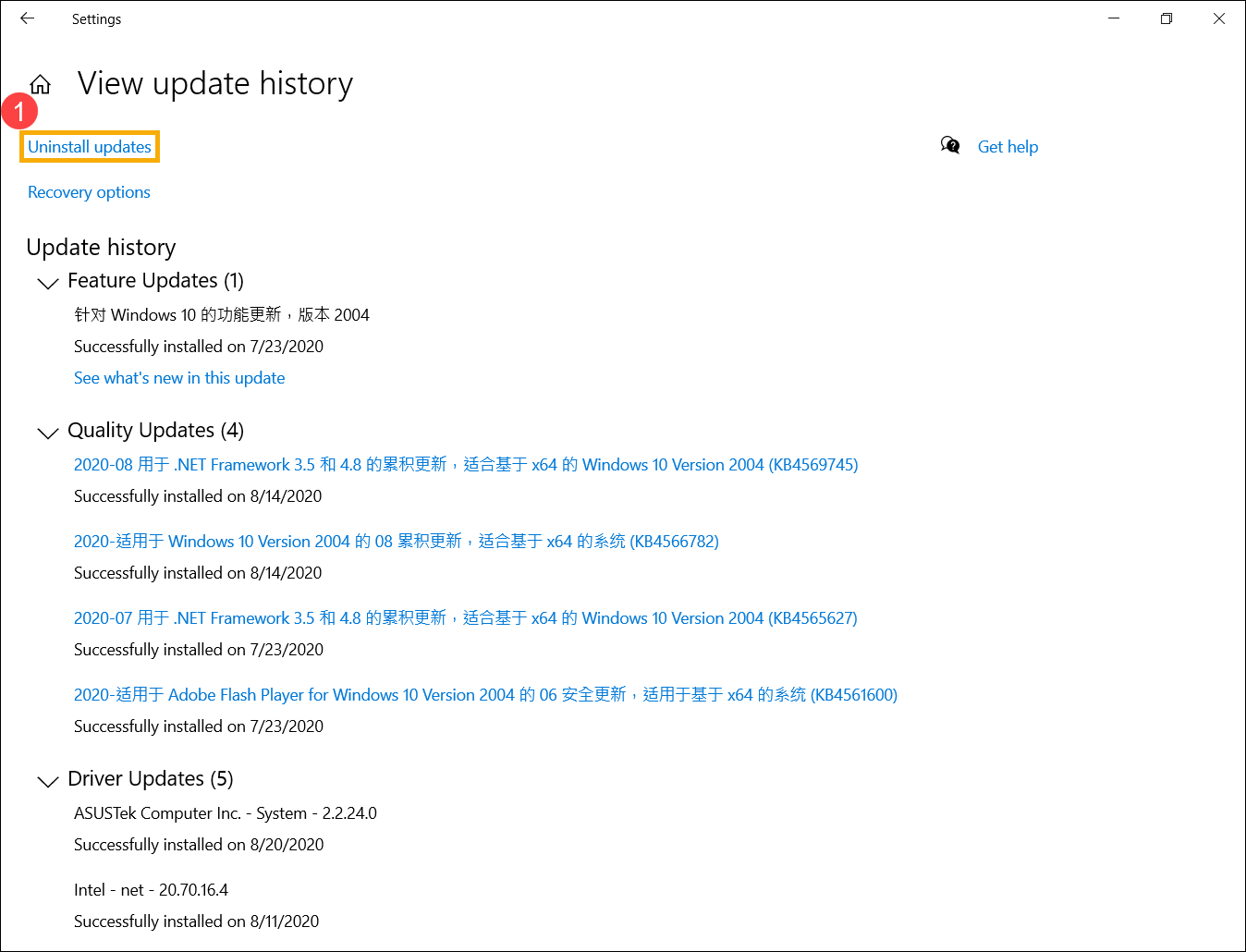
- Select the item which you want to remove②, then click [Uninstall]③.
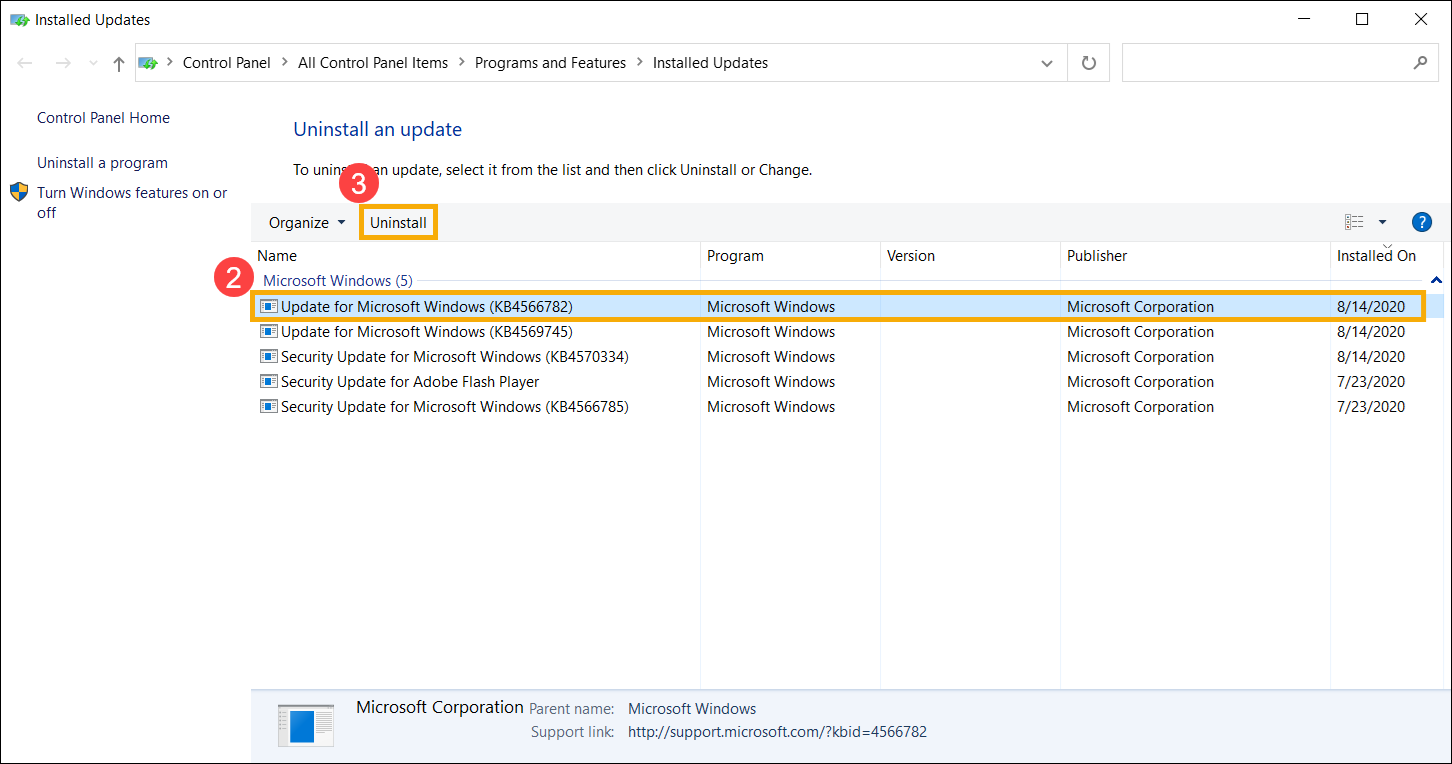
Go back to the previous drivers version
If you experience auto shutdown/restart problem after updating drivers in Windows, we recommend that you go back to the previous version and wait for the fixed one. Please refer to the following steps to know how to go back to the previous driver version.
- Type and search [Device Manager] in the Windows search bar①, then click [Open]②.
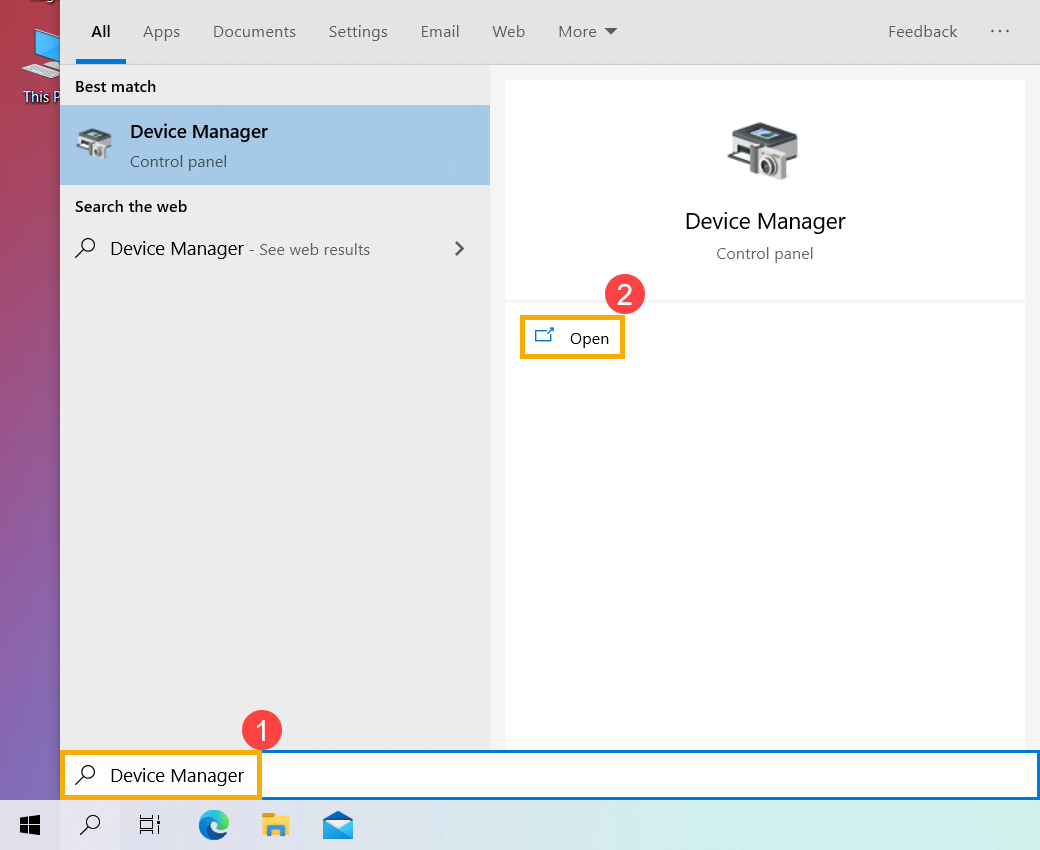
- Check the arrow next to [Display adapters]③, then right-click the [Intel(R) UHD Graphics 620]④ and select [Properties]⑤.
The following steps are used Intel graphics as an example, please select the defective driver which you would like to roll back to the previous version.
- Select [Driver]⑥, then select [Roll Back Driver]⑦.

- Select the reason of [Why are you rolling back?]⑧, then click [Yes]⑨. The system will start rolling back to the previously installed driver.

Uninstall a specific application
Auto shutdown/restart problem may occur if there is a compatibility issue between an initial installed application and Windows system, so we recommend that you uninstall this application first. Here you can learn more about How to search or uninstall recently installed applications.
If the problem is gone after uninstalling this application, we recommend that you check the supported Operating System or specification in this application’s official website, or contact the application manufacturer for support.
If the problem persists after above steps, please continue to the next troubleshooting step.
Restore the system from restore point
If the problem happens recently, and if you have ever created a restore point or there is an automatic system restore existed, try to restore the device to a point before the problem began to resolve the problem. Here you can learn more about How to use restore point to restore the system.
If the problem persists, please continue to the next chapter for troubleshooting.
Reset your PC
If the problem persists after all troubleshooting steps are completed. Please backup your personal files, then reset the device to back to its original configuration. Here you can learn more about How to reset the system
If your problem is not worked out with above solution and information, please contact ASUS customer service center for further information.